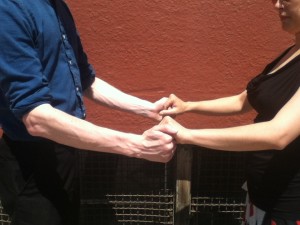Previously, we discussed some of the assumptions leaders make that can hold back their ability to effectively connect with their partner. Now it’s time to look at the techniques that actually help you get your partner from point A to point B - and keeping her smiling on the way.
Partner connection
I’ve gone over this before, so let’s break it down a little more this time. To effectively lead your partner, you require two things: frame and pressure. For a description of frame, go to my second point in part 2.
As a leader, stay focused on the contact points, or the places where you and your partner’s hands connect (usually hand-to-hand, or hand-to-shoulder blade). Your frame may flex slightly, but the hand-to-hand connection should stay in the centre, to avoid over-extension or collapsing of the frame.
Both leader and follower work together to keep a light and responsive pressure through the contact points. If you move forward one foot, you entire frame will move forward the same amount. Your partner will move back the same amount to keep the pressure equal. Voila! You’re moving together.
How to connect
When practicing connection for the first time, I recommend you begin in a two-hand hold. Keep the arms rounded towards your partner, as though you were about to give her a hug around her waist. When connecting, your forearms should connect directly with your partner’s, creating a straight line from your elbows to hers. This ensures the pressure should run through the centre of the connection.

As you increase familiarity with leading, you may switch to a closed hold. Your right arm curves gently downward from the shoulder, as though you were a butler carrying a towel, the hand connecting with your follower’s shoulder blade, and her left hand connecting to the crease between the right bicep and shoulder muscle. The opposite hands are clasped with the follower’s fingers between the leaders thumb and fingers at eye level.
Initially, you might want to keep about half a foot between yourself and your partner, to avoid crushed toes and egos underfoot.
Time to move
When approaching a door, do you kick it open with your foot, or lean in with your upper body? Hopefully most of you answered the latter, because leading through the chest quickly tells your partner where to go. Every direction you step in, start by leaning in slightly from the upper body to give your partner a head’s up. After all, she doesn’t know what you have planned, so let your body do the talking.
Stick to the plan
Speaking of which, make sure you plan ahead! An easy way to this is using what I call the Leadership Game. Start by yourself (or a patient partner) dancing the most basic pattern you know, 3 times. Use those three basics to decide what pattern you would like to lead afterwards. Once you’ve completed the ‘surprise pattern’, repeat the 3 basics, planning ahead for a new pattern, and so on. Put together, it looks like this:
Basic 1 —> Basic 2 —> Basic 3 —> Surprise —>
Basic 1 —> Basic 2 —> Basic 3 —> Surprise —> etc…
As you get more experienced at planning, you can gradually decrease the number of basics you use, with the ultimate goal of eliminating them altogether.
This completes our overview on how to take your leading and following to the next level. If you feel I’ve missed something, let me know in the comments! Until next time, and happy dancing.
